Acer Aspire AS5740G-6979: Budget Priced but Great Gaming
by Dustin Sklavos on April 2, 2010 7:39 PM ESTThe 4GB of memory and quad-threaded Intel Core i5 430M processor may be on the high end of bog standard for modern notebooks, but remember that it's still a lot of power for a sub-$800 machine, especially when you factor in the Mobility Radeon HD 5650. A refresh of the configuration of our review unit:
|
Acer Aspire 5740G-6979 Testbed |
|
| Processor |
Intel Core i5 430M (2x2.26GHz, 32nm, 3MB L3, Turbo to 2.53GHz, 35W) |
| Memory | 2x2GB DDR3-1066 (Max 2x4GB) |
| Graphics |
ATI Mobility Radeon HD 5650 1GB GDDR3 (400 SPs, 550/1.5GHz Core/RAM clocks) |
| Display | 15.6" LED Glossy 16:9 768p (1366x768) |
| Hard Drive(s) | 500GB 5400RPM HDD |
| Optical Drive | 8x DVDR SuperMulti |
| Battery |
6-Cell, 12V, 46Wh battery "Up to 3 Hours" |
| Operating System | Windows 7 Home Premium 64-bit |
| Pricing |
$748 Online $799 from NewEgg |
While synthetics aren't ideal for gaming performance, for basic computing performance they can still be helpful. We tested the Aspire 5740 in PCMark05 and PCMark Vantage to see how it stacked up to some of the other units we've reviewed. Pay particular attention to the ASUS N61Jv and the Alienware M11x, which are two of the closest competitors in terms of providing reasonable gaming performance for under $1000. We've highlighted their results in the performance benchmarks for ease of comparison.
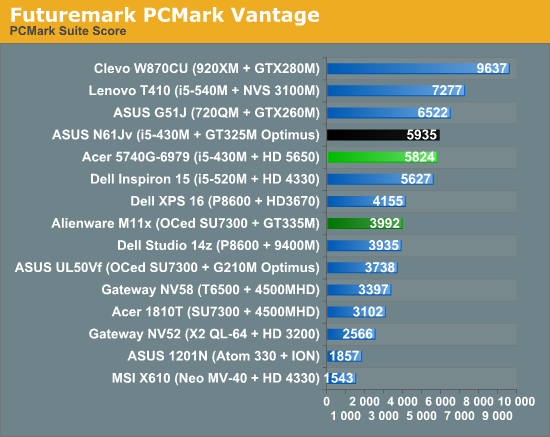
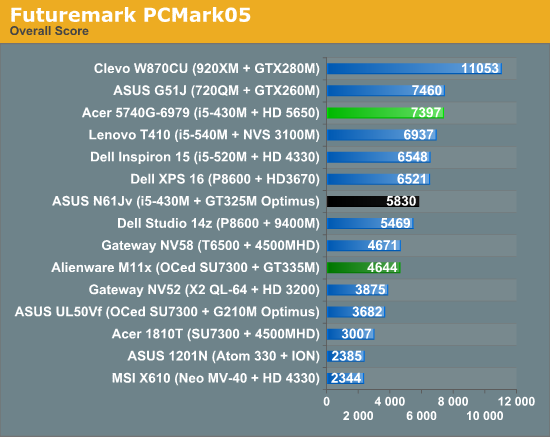
What's interesting to note here is the way the HD 5650 helps the Aspire score substantially higher than the Inspiron 15, a unit equipped with the next fastest processor from Intel. You can also see how much faster Core i5 is relative to Core 2 Duo and overclocked CULV (i.e. the M11x)—around 50% higher performance in PCMark. Another interesting point of reference is the ASUS G51J with a quad-core i7-720QM CPU; despite a default clock speed of just 1.6GHz, Turbo Mode is in full effect and the 720QM stays ahead of the Core i5 competition.
Rounding out our processor performance metrics are Futuremark's Peacekeeper browser benchmark, Cinebench 10, and an x264 encoding routine.
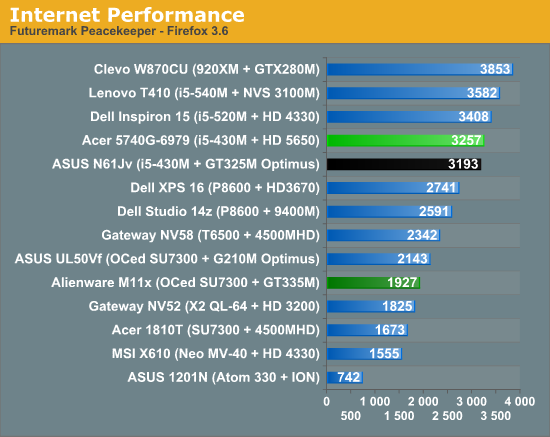
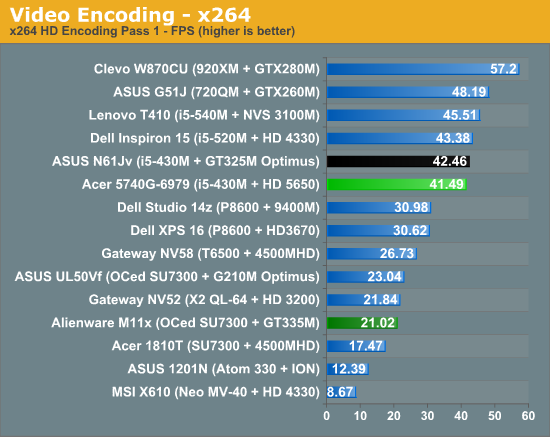
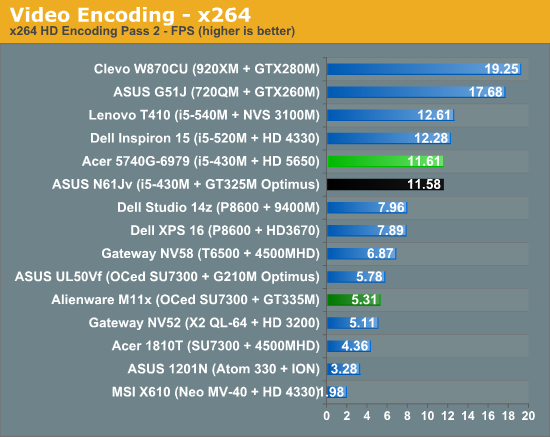
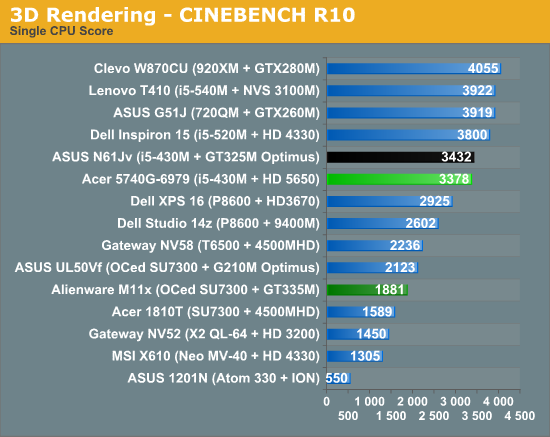
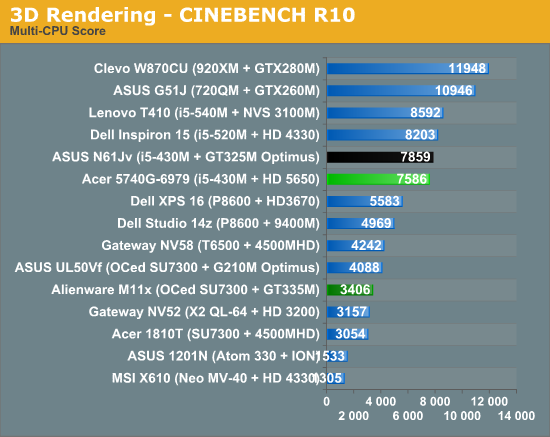
In each case, the Core i5 430M is hot on the heels of the slightly faster i5 520M in the Dell Inspiron 15, trailing by around 5%. The exception is Cinebench where performance is markedly lower. It's possible that the 300MHz gulf between the top turbo speeds of these two chips is manifesting here. Either way, the single-CPU test is 12% slower and the multi-core test is 8% slower. As seen in PCMark, an i7-720QM maintains a comfortable lead over the i5 CPUs as well with its more aggressive Turbo Modes. Only the i5-540M is able to keep up with the 720QM in the single-CPU Cinebench result, while the multithreaded score is substantially higher.










31 Comments
View All Comments
Fastidious - Saturday, April 3, 2010 - link
You'd think they'd put a bigger battery in it at least. I never understand laptops that have shitty battery life since the whole point of them is to be mobile. Two hours is terrible for a new laptop.Alurian - Saturday, April 3, 2010 - link
Agreed. What point is there in having a lighter laptop to carry around if it doesn't have the battery life for you to actually use it?Miggleness - Saturday, April 3, 2010 - link
That's where customers needs to balance things out. There's not gaming laptop under a grand that has decent battery life. Being mobile can mean you can easily lug the laptop anywhere, just be sure to plug it in. Can be a convenience to quite a number of people I know who game.vol7ron - Saturday, April 3, 2010 - link
Mobile devices don't always mean being able to use it at the beach, or use it on a train, w/o needing to plug it in. Instead, what's it's come to mean is that you have the luxury of TAKING IT PLACES with the opportunity of plugging it in; whereas lugging a desktop (and monitor) around with you is more of an inconvenience.I do agree that battery life should be better, since it seems like it takes 2 hours to wade through spam and check mail, but that is why they make multiple batteries of various capacities. There are also different uses for laptops; gaming is one of the most power hungry things you can do on a laptop, if you're using a kickass video card with a decent performing screen and expect high quality response, then you're going to need more juice. Such a laptop would be expected to be plugged in. Having such a system in a laptop case enables you to play at school, or on vacation, as well as at home.
Hrel - Saturday, April 3, 2010 - link
Seriously, I WANT to give them more money for a 1600x900 screen. And preferably a 7200rpm hard drive and a higher capacity battery wouldn't hurt but it's not really necessary.chrnochime - Saturday, April 3, 2010 - link
Well Considering that envy 15 is known to be hot as heck and with equally low battery life(the former being much more unavoidable), I think users would prefer either going with optimus or cooler (pun intended) designs.chicagotechjunkie - Monday, April 5, 2010 - link
The gen 1 envy had some heat issues, but the newest generation doesn't get very hot at all. after a full suite of benchmarks, the GPU never broke 72C (that's with an overclock). The palm rest and underside got a little warm, but nothing that was abnormal imo.blackshard - Saturday, April 3, 2010 - link
Why there are no AMD laptops in comparison? I mean, the only one is the gateway NV-52 with the old Athlon QL-64 and integrated graphics. Why there are no Turion II, for example? It would be nice to know the difference with higher priced notebooks.jasperjones - Saturday, April 3, 2010 - link
Anandtech delivers the best laptop reviews imo.However, I am getting more and more disappointed that virtually every laptop reviewed here features dedicated graphics. Why limit yourself to serving laptop gamers and people needing mobile business graphics cards? I can't be the only reader that prefers integrated graphics on a laptop (I assume there might be fewer readers that prefer integrated graphics on a desktop).
mtoma - Saturday, April 3, 2010 - link
Hello!There is something that really bothers me about Anandtech (otherwise my favorite tech site): why on Earth the laptop reviews ignore the long term reliability of the products? I am the co-owner of a computer repair-shop in Romania (in Europe, if you don't know where that country is).
And I can tell you first hand that 95% from all the laptops we repair are ACER!!!!! The motherboard often fails, there are serious flaws in the assembly quality, and in the medium and long run, these laptops suck!!!
When asked, the customers say that these laptops are cheap (they are the cheapest on the market, really) and they are confident on the reliability of a new product (which is, of course, a bad assumption). Here in Romania we have only one year warranty on the ACER machines, and of course, this tells us a lot about the quality of ACER laptops.
I believe, and I strongly suggest, that this respected site (and others who sell/buy those products) should care more about the medium and long term reliability of any tech product, because, often, the cheapest product is usually the worst buy decision. And, the cheapest laptop with a particular technical specification, has really NOT the best bang for the buck!
Suggestion: this site is very carreful about the realiability of the SSD drives, and in this regard his laptop reviews must be more aware.